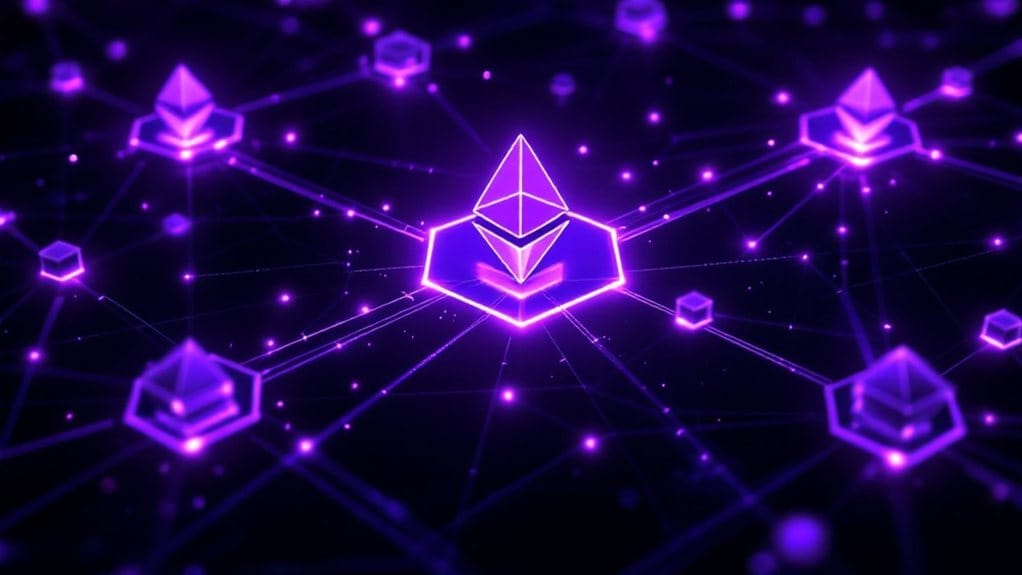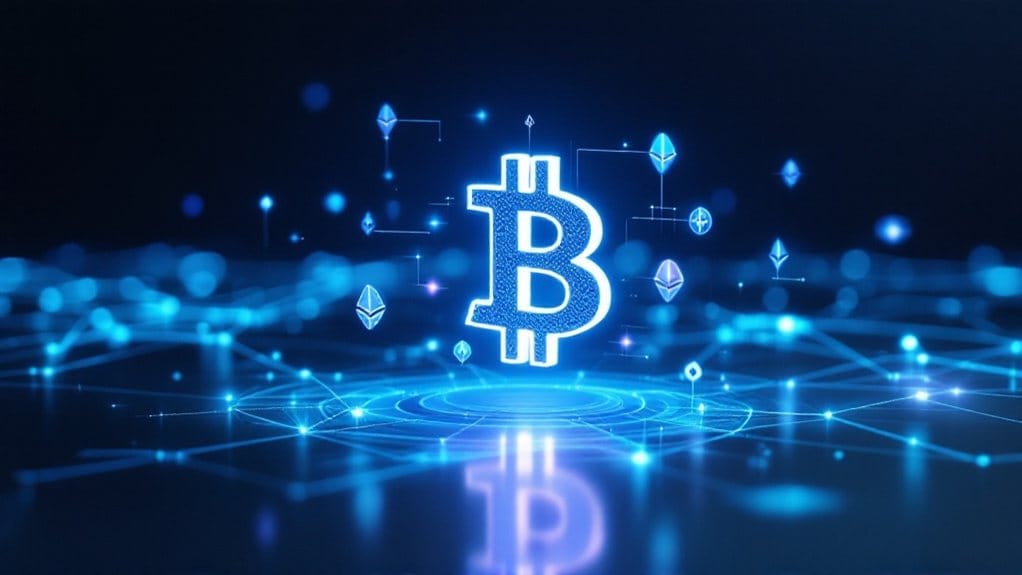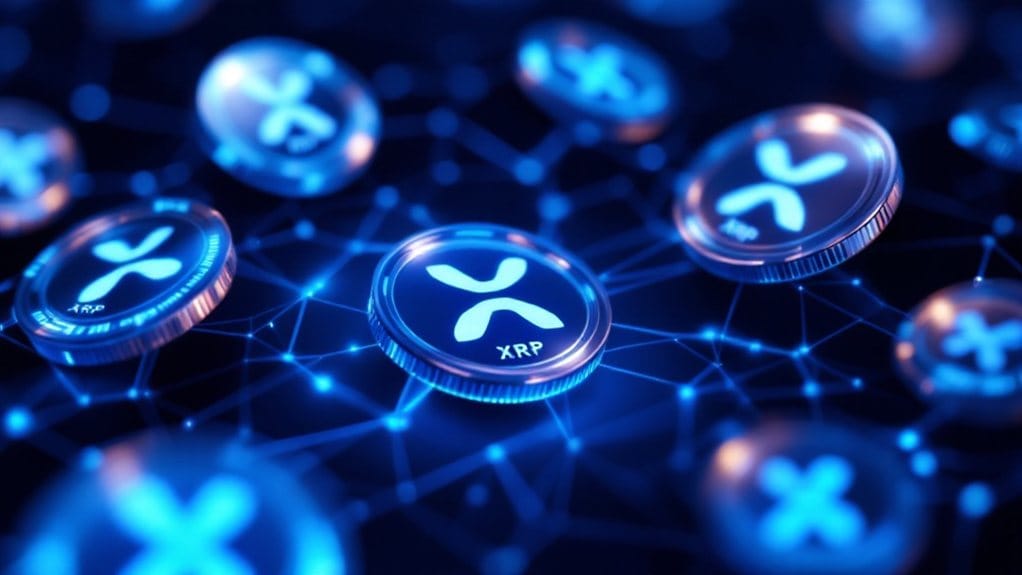Polygon, formerly Matic Network, functions as a Layer 2 scaling solution for Ethereum, processing transactions on sidechains before finalizing them on the mainnet. The platform utilizes the MATIC token for transaction fees and governance, while supporting the Ethereum Virtual Machine for seamless application deployment. Operating as a complementary system, Polygon achieves faster transaction speeds and reduced costs through its sidechain architecture and Plasma technology, making blockchain scalability accessible. Understanding its architecture reveals how it’s transforming Ethereum’s ecosystem.

While blockchain technology continues to evolve, Polygon (MATIC) has emerged as a groundbreaking Layer 2 scaling solution for the Ethereum network, offering improved transaction speeds and reduced costs through its innovative sidechain architecture. Originally launched as Matic Network before rebranding in February 2021, Polygon utilizes Plasma technology and sidechains to augment Ethereum’s capabilities while maintaining full compatibility with its ecosystem.
The network’s infrastructure operates as a complementary system to Ethereum, processing transactions on its sidechains before periodically submitting checkpoints to the Ethereum mainnet for security validation. This architecture enables Polygon to achieve notably faster transaction speeds and lower gas fees compared to Ethereum’s main network, while still benefiting from Ethereum’s robust security framework. Users must be careful to avoid sending tokens between different blockchain versions to prevent loss of assets. The platform’s future roadmap includes implementation of zk rollups to further enhance scalability. Similar to other Layer-2 solutions, Polygon helps maintain network decentralization while improving transaction throughput.
The platform’s support for the Ethereum Virtual Machine (EVM) allows developers to seamlessly deploy existing Ethereum applications without major modifications.
At the core of Polygon’s ecosystem lies the MATIC token, which serves multiple essential functions within the network. Users employ MATIC for transaction fees, network participants stake tokens to secure the system and earn rewards, and token holders participate in governance decisions that shape the platform’s future development.
With a maximum supply cap of 10 billion tokens and approximately 7.5 billion in circulation, MATIC’s value is intrinsically linked to the network’s adoption and utility.
Polygon’s modular architecture represents a notable advancement in blockchain scalability solutions, allowing developers to create customized chains tailored to specific needs while maintaining interoperability with Ethereum.
The platform’s vision extends beyond simple scaling, aiming to facilitate an “internet of blockchains” where multiple Ethereum-compatible networks can interact seamlessly. Through its sophisticated infrastructure and strategic positioning as an Ethereum scaling solution, Polygon has established itself as a vital component in addressing blockchain scalability challenges while maintaining the security and decentralization principles that make blockchain technology valuable.
FAQs
What Platforms and Exchanges Support Trading of MATIC Tokens?
MATIC tokens are supported across major centralized exchanges including Kraken, Coinbase, Bitfinex, and Bitstamp, offering different fiat and cryptocurrency trading pairs.
Decentralized exchanges like PolySwap, MaticSwap, and QuickSwap provide alternative trading venues on the Polygon network.
These platforms offer a variety of trading options, including spot trading, while select exchanges like PolyX and Kraken also support advanced features such as margin trading and futures contracts.
How Does Polygon’s Gas Fee Structure Compare to Other Layer-2 Solutions?
Polygon’s gas fee structure maintains significant advantages over competing layer-2 solutions, with average transaction costs ranging from $0.0001 to $0.02.
Compared to Optimism and Arbitrum, which typically charge $0.15-$2.00 per transaction, Polygon offers substantial savings.
The platform’s efficient Proof-of-Stake mechanism and high throughput of 7,000 TPS enable these competitive rates, while maintaining security through its validator network and modular architecture.
Can I Stake MATIC Tokens, and What Are the Rewards?
MATIC tokens can be staked through multiple platforms, including MetaMask and Coinbase Wallet, with minimum requirements starting at 1 MATIC.
The staking process involves delegating tokens to validators, offering average rewards of 4.46% APY, though some platforms provide up to 20% interest based on duration and amount staked.
Users can earn passive income while supporting network security, with unstaking periods typically lasting 3-4 days.
What Security Measures Does Polygon Implement to Protect User Assets?
Polygon implements multiple security layers to protect user assets through its Proof-of-Stake consensus mechanism, where validators stake MATIC tokens as collateral against malicious behavior.
The network employs regular smart contract audits, partnerships with security firms like CertiK, and Zero-Knowledge proofs for secure authentication.
Furthermore, pessimistic proofs safeguard bridge operations, while bug bounty programs incentivize the community to identify vulnerabilities, ensuring robust asset protection.
How Do I Bridge Assets Between Ethereum and Polygon Networks?
Bridging assets between Ethereum and Polygon networks requires connecting a Web3 wallet like MetaMask to the official Polygon Bridge platform.
Users select their desired assets and choose between PoS Bridge for faster transfers or Plasma Bridge for improved security.
After initiating the transaction, users must wait for confirmation, which typically takes 7-8 minutes for PoS and 3 hours for Plasma bridges, before accessing their assets on the destination network.









